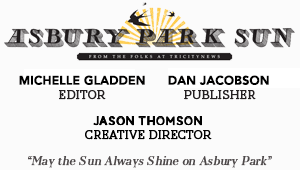The planning board last night voted to grant Johnny Mac House of Sprits owner John McGillion permission to begin construction on a large-scale project that includes a beer garden, mezzanine structure and a new bar atop the current Bistro Olé restaurant.
The vote passed 4-1. Planning board member Robert Feinstein voted no.
It was McGillion’s fourth appearance in front of the planning board in regard to the application for the project.
Johnny Mac’s is located at 208 Main St. Just north of the tavern is a parking lot. The building housing the restaurant Bistro Olé is adjacent to the lot. McGillion purchased the Bistro Olé building last year. He plans to keep Bistro Olé as a first-floor tenant, but he will build a new tavern, Mary Mac’s Libation Station, on the second floor, he said.
Mary Mac’s and Johnny Mac’s will be joined by a beer garden and mezzanine, both with outdoor tables and seating [pictured above], in what is now the parking lot. McGillion will also add a third and fourth floor to the buildings in the rear of the parking lot. Those areas will be available for weddings and events.
The construction is scheduled for four phases.
Phase one includes the construction of two covered bars in a beer garden area that is currently part of the parking lot adjacent to the Johnny Mac building. McGillion had hoped to have the first phase of the plan completed by midsummer, but needed the board’s approval to do so. Setbacks like late submission of plans and requests for more details of the individual phases delayed construction, as previously reported in the Sun.
During the second phase, bathrooms and a new kitchen next to the planned beer garden will be installed. Construction on the Mary Mac mezzanine bar and a neighboring mezzanine above the beer garden will also begin. A canopy in front of the Johnny Mac building will also be put into place.
The rear façade will be built during the third phase of construction. Improvements to the rooftop of the Bistro Olé building are also scheduled for this phase.
Phase four will see the full completion of the project. It includes final façade improvements to all levels, construction of a bridge between Johnny Mac and Mary Mac and refinement of the sidewalk and outdoor amenities.
All four phases are scheduled to occur in 18 month increments, dating the completion of the project for June 2018. Phase one is scheduled to be completed by September 2014.
McGillion’s lawyer, George McGill, Belmar, presented the planning board with detailed architectural renderings it had requested at a June 10 meeting. He called project engineer Carolyn Feigin as a witness to address specific issues.
Feigin went through an itemized list of changes to the project that were made based on recommendations from the planning board:
– Details of the streetscape were addressed first. In order to provide the required 5-foot pedestrian walkway, 8 bike racks on Main Street and 10 racks on Mattison Avenue were rearranged and planters were moved. Feigin also showed plans for the removal of two trees that currently exist on the property that will be replaced with eight new trees. Approval from the Shade Tree Commission for the planting of the trees is still required. Documentation was provided to the commission a week ago, according to Feigin.
– The planning board had previously taken issue with the heaters that would be installed below the marquis canopies over the Johnny Mac bar to keep patrons warm during the colder months. The board raised concerns over the structural integrity of the steel used to construct the canopies when exposed to the heat, Feigin said. Feigin presented a letter from Kevin Summons of KSI Structural Engineering, who designed the marquis canopy. It stated the heaters would run at a temperature that would not compromise the steel used to construct the canopies.
– Updated plans that add water as well as sewer access to temporary outside restrooms were provided.
– A revised rear access plan was updated to provide steps and a fence to guide patrons out to the existing easement for emergency egress.
– A schedule of all signage that would be put up was provided along with details of the function of the sign and whether the signs themselves would have lighting. The plans also provided detailed explanations of the lighting fixtures.
The board’s engineer, Diane Nuno, said she was satisfied that all the board’s issues were addressed.
The reconstruction will cause McGillion to give up 21 parking spots. It was agreed after phase three of construction is complete, he will begin contributing to the city’s parking fund.
Andrew Markou of ASA+Zambrano Architects in Metutchen, who is not a licensed architect but helped prepare the architectural plans, discussed the styles of shade fixtures and goose neck lamps that will be used on the outside façades of the buildings. The board ruled McGillion would have to change the size of some lamps so that they would fit under the building’s cornice.
Markou also brought samples of shingles that will be used on the bar roof, materials for the signage on the front façade and fabric samples for canvas awnings that will be put up in the beer garden and on top of the Bistro Olé building.
After Markou’s testimony, the board raised two separate issues about window coverings and any other adornments that might be included on the new construction.
The board called the current decorations on the exterior of Johnny Mac’s into question, which McGillion calls “festooning.” Festooning, in this case, includes the small trinkets and signs that currently exist on the Johnny Mac façade. The board decided if McGillion wishes to put up any signage outside of what is on the current plans, he would have to resubmit site plans to the board for approval.
If there is something added to the buildings during or after construction the board does not like, “we’ll take it down,” McGillion said.
City zoning officer Barbara Van Wagner brought up a compliance issue concerning decoration and lettering on the front windows of Johnny Mac’s. Current city regulation states no more than 20 percent of any window can be covered. Van Wagner believes the current lettering and decorations violate the policy, and has discussed it with attorneys but hoped to get the issue resolved with the board, she said.
McGillion testified he had brought in a consultant who tested the measurement of light passing through with a computer program that measures pixels in a window. According to the consultant, the current blockage is 17.3 percent, which falls under compliance.
The board could not authenticate the findings without the consultant there to give testimony. The board ruled if the city found McGillion out of compliance, a summons would have to be given and the issue would have to be resolved through another legal entity.
McGillion said he was sure a judge would rule in their favor.
————————————————————
Follow the Asbury Park Sun on Facebook and Twitter.















